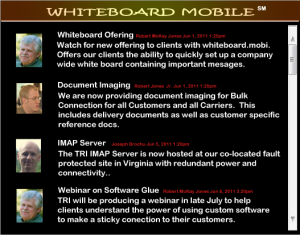Here is an opening for a conversation. Calendar 20-20 is the name we have given to a new calendar project we are working on at TRI this month. We have used the calendar in Outlook for more than a decade and we have used the Google calendar for almost as long. These calendars are only moderately adequate. Here is a short requirements list of things we feel are missing from our Outlook or Google calendar. We intend to fix that problem.
- Associate calendar entries to a project
- Associate calendar entries to a client, associate or contact
- Associate calendar entries to an employee or group member
- Associate calendar entries to a task
- Permit drag and drop editing
- Grouping calendar entries by task within project, within client or contact within employee
- Manage projects better by allowing all the tasks associated with a project to be rescheduled or cancelled as the project changes state
- Prioritizing calendar entries
- Adding comments to calendar entries
- Add activities or requirements to calendar entries
- Allow clients to see and/or manage calendar entries specific to them on the web
- Allow employees to see and/or manage calendar entries specific to them on the web
- Allow supervisors to review calendar entries for all employees
- and clients Although Calendar 20-20 will replace the need to use the Outlook calendar, for those who wish, Calendar 20-20 can be downloaded and overlaid on top of an Outlook calendar.
- Print or display calendars in special report formats
- Listings by task by date
- Listings by client and include tasks and dates
- Listing by employee and include clients, tasks and dates
- Daily task list for employees and supervisors
- Special Monthly or Weekly calendars with avatars depicting employees, projects, clients and tasks
- Interactive day view that allows a supervisor or employee to better manage a client
If you agree that we need to bring calendaring into the new millennium, please drop us a line and let us know what we are missing. How can a calendar be improved to help YOU in your business? Let us know!


